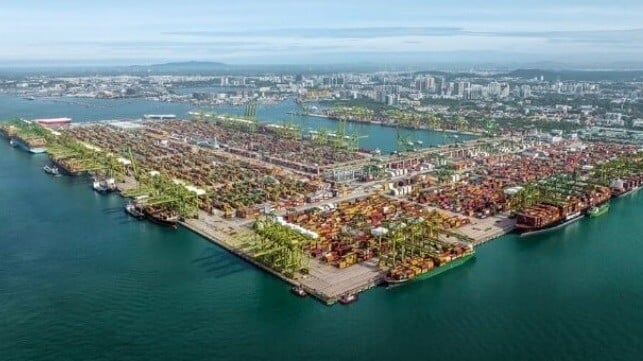Singapore Backlog Continues as Nearly All Boxships Arrive Off Schedule

Singapore’s Minister for Transport outlined to the Parliament steps being taken to address the continuing problems in the port resulting in increased waiting time for containerships. The growing backlogs came to light earlier this year as a result of vessels diverting from their normal routes through the Red Sea.
“About 90 percent of container vessels are arriving off-schedule, compared to an average of about 77 percent for 2023,” Minister Chee Hong Tat writes to Parliament. He highlights that the ships are also arriving in a short window of time which has resulted in “vessel bunching” at the port.
Emphasizing the challenges, the Ministry reports in the first five months of 2024, the port has handled 16.9 million TEU. That was a 7.7 percent increase compared to the January through May 2023 period.
In addition to the challenges of vessels arriving off-schedule, the minister highlights that carriers are increasingly using Singapore as a transshipment port. Carriers he says are turning vessels around at Singapore instead of continuing to Asia in an effort to address the longer sailing times and the impact on schedules in Europe.
As a result, he writes that the complexity of container handling has increased and vessels are spending more time on dock. Container lines are also using their time in Singapore to rearrange containers on the vessels to facilitate improved operations at downstream ports.
The Ministry warns that these conditions are likely to continue while saying it is working with its partners including terminal operators to take steps to improve the situation. They have reactivated some of the berths and yard space at both the Keppel and Tanjong Pagar Terminal which had previously been closed as the port begins a transition to the new Tuas facility. Long-term, Singapore plans to relocate operations to Tuas, which when completed will have a capacity for 65 million TEU.
Starting July 1, a new berth was opened at Tuas. They also plan to open another new berth in October and a third in December. If the increase in demand is sustained, they report PSA will also expedite the development of additional capacity. They are also committing to keeping the Pasir Panjang Terminal in operation until at least 2040 to provide for additional capacity overall as Tuas proceeds with developing additional capabilities.
Additionally, Singapore is also looking to the carriers noting that the time at anchorage should be used for bunkering and resupply. They are also working with the carriers to optimize vessel arrival times.
Hong Kong-based market intelligence firm Linerlytica reported at the end of May, that as many as 450,000 TEU were in the queue in Singapore. They warned that the wait was up to seven days in some cases for a berth in Singapore and that it was causing ships to hold off, sometimes at distance anchorages, due to a lack of berth space. While the backlog has come down from the peaks last month, Linerlytica currently shows nearly 200,000 TEU on 21 vessels in the anchorage at Singapore.
Linerlytica’s leaderboard of port congestion however shows that Port Klang in Malaysia and Shanghai/Ningbo in China have an even higher ratio of queue to berth. Asia remains the hotspot for port congestion.
